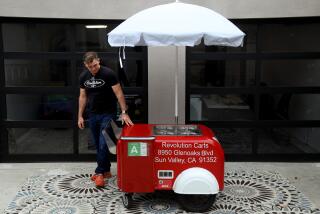Secret ingredient to starting a farmers market? Community
- Share via
“WE just felt there was the critical mass for a market downtown,” says Susan Hutchinson, manager of the Arts District Little Tokyo farmers market, which opened last July in a neighborhood that’s been growing in population as new residents fill recently completed apartments and loft conversions.
“There was a lack of options around here, no farmers market or supermarket.”
That original reason for farmers markets -- getting fresh produce into underserved communities -- is still an important factor for the new markets that start up every year. Whether they’re located in church parking lots, city parks or on streets that are closed for a few hours, farmers markets are collaborative projects.
So who starts them up, and how?
Networks of nonprofit organizations, business groups, professional market managers and community activists are behind most markets, and each group has different ways to measure a market’s success. Although it often takes intense negotiation, for example, to close streets for a newly created farmers market, nowadays even malls are offering space. The markets’ popularity as gathering places or street fairs means foot traffic.
Gary Larson, executive director of the West Covina Chamber of Commerce, describes the new Tuesday evening market it’s sponsoring at Westfield Plaza in terms of family participation and fun.
“Families can come in the evening and bring kids, they can shop and there’ll be entertainment and jumps for the kids.”
But some markets have been established to serve very small, focused populations.
A year ago, the Model Neighborhood Program opened a tiny seven-farmer market at the Kaiser Permanente Hospital on Cadillac Avenue in Los Angeles.
“The public can come,” says director Cynthia Ojeda, “but it’s basically for the staff and community of Kaiser. It’s just a little market to promote wellness.”
To start a farmers market, there has to be a sponsor, nearly always a city government, charity or other nonprofit organization. (A group of certified farmers is permitted to start a market too, but there are no examples in our area.)
Often the location is tied into the sponsorship. Because of the complexities of acquiring appropriate permits and attracting and maintaining relationships with farms and vendors, most farmers markets have a professional market manager.
But it’s not always easy.
Several market managers mention that it’s gotten hard for a new market to find farmers. “Farmers are stretched these days,” says Jerry Dahlberg, who’s managed four markets and is about to open the new West Covina market.
“How many guys can you [as a farmer] afford to hire, or spare from your farm, to drive your crop into town and sell it at a market? Going into new markets means tying up trucks and employees, and the result is the farmers make less money in each new market.
“Also, new markets may steal business from older ones, so that drives profits down too.” Dahlberg says one day there may be legislation limiting the number of markets in an area.
Harder than it looks
FOR each new market that opens, a struggling one goes under. Reasons for market failure vary, but the chicken-and-egg equation of having enough customers buying from the farmers whose produce appeals to them is the key to market success. And what might look like a carefree street fair takes a lot of work to get right.
But regardless of the challenges, new markets open every year. Pompea Smith, whose Sustainable Economic Enterprises of Los Angeles runs the Atwater Village market (among others), which is coming up on its first birthday, says, “The community is very supportive of the concept, a way of bringing the community together. We have activities, storytelling almost every Sunday, local musicians for the children. We encourage local people, like a local man who makes mozzarella. One lady started a little business selling herbs from her backyard.”
In the end, it’s about community.
More to Read
Eat your way across L.A.
Get our weekly Tasting Notes newsletter for reviews, news and more.
You may occasionally receive promotional content from the Los Angeles Times.










